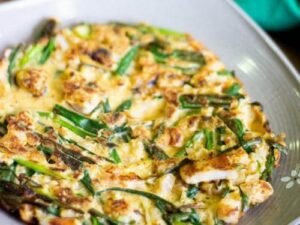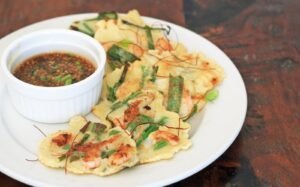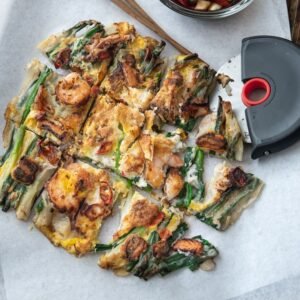A dish that is sure to please a crowd, pajeon is savory and tasty and makes the perfect accent to any Korean supper. You should become an artist by learning how to cook “Haemul Pajeon,” which are Korean pancakes filled with fish and green onions. This is not difficult at all!
Korean pajeon, or 파전 as it is commonly known, is one of the dishes I will be serving today. Throughout the day, it is one of the meals that is most commonly requested.
What is the PAJEON specifically?
A variety of Korean pancake known as pajeon can be identified from other varieties by the substantial quantity of green onion or scallion used in its cooking. This suggests that you could translate it as scallion pancakes or green onion pancakes.

It is often prepared with an egg, water, and seafood, along with some green onions and a Korean pancake mix that can be bought readymade or made at home. Normally, the preparation process also includes green onions.
The term Haemul Pajeon, which is also spelled 해물파전, refers to the pancakes that are filled with seafood and green onions in Korean cooking. Of course, I limit this lunch to prawns and squid or calamari, but feel free to add any other seafood you prefer, like clams, mussels, oysters, and so on. Only these two types of seafood are listed.
If, however, you are a vegetarian or have a seafood allergy, you can simply omit the seafood from the recipe and continue preparing it with the remaining components. Some people also add a very tiny quantity of ground beef to this recipe, but because seafood is the main ingredient, I think it’s a far better option for the dish’s principal source of protein.
As opposed to BUCHIMGAE (嶀침개), also known as JEON .
The Korean nouns Jeon and Buchimgae, when translated into English, stand for two different things: Korean pancakes and Korean pancakes. These two words have Korean linguistic origins. Conversely, however, what distinguishes them from one other?
The “cooking technique” is the primary characteristic that sets them apart from one other, based on what little information I have gathered from the Korean Naver online community. Nevertheless, I cannot categorically say that this is the case in every way.
Combine all of the ingredients that have been prepared for Buchimgae in a large mixing basin. Throughout the process, these elements include flour, water, meat, veggies, and so forth. After being ladled up and added to the heating pan, the ingredients are then cooked.
To create jeon, the main ingredients, which consist of meat and veggies, are first coated separately with a flour mixture and then arranged separately on a frying pan. This makes it possible to optimize the forms and contents of the individual components, producing the intended result.
On the other hand, it is possible to come to the conclusion that a sizable portion of Koreans interchangeably refer to jeon and buchimgae.

Another famous pajeon is Dongnae Pajeon (동래파전).
Dongnae Pajeon (동래파전) is a well-known type from Busan, South Korea. Based on this video (made by Busan Metropolitan City), you’ll notice that Dongnae Pajeon is considerably different from my recipe.
Surprisingly, some people dislike Dongnae Pajeon since its texture is so different from conventional pajeon. Apparently, it has a more mushy wet texture than a crispy texture.
HOW TO SERVE PAJEON:
Dongnae Pajeon is typically served with Cho-gochujang, a Korean dipping sauce that is sweet, acidic, and spicy. However, ordinary pajeon is served with a sweet and tangy Korean pancake dipping sauce, which is quite excellent! I hope you can try my pajeon and pancake dipping sauce recipes!
MY PAJEON-MAKING TIPS
According to my findings, using high-quality sparkling water can improve the crispness of your batter. However, it will thicken your batter, making it less spreadable on the pan than water. But I believe it is worthwhile to try considering the greater likelihood of having crispy Korean pajeon!
Cooking temperature varies based on the heat source (gas cooktop, electric cooktop, etc.) and the type of pan used. Adjust the heat level properly, as the pancake can burn easily. Similarly, if the frying temperature is set too low, the batter will absorb too much oil and become soggy rather than crispy.
If you wish to serve the dipping sauce alongside the pancakes, make it ahead of time. This is done so that you can eat the warm, crispy pancakes immediately after they are cooked.
If you don’t use all of the ingredients right away, you may store them in the fridge for 1 to 2 days. Store the pancake mixture, fish, and vegetables separately in an airtight container.
You may reheat cooked pancakes in the microwave, on the stove, or in an air fryer.
P.S. Do you have too many green onions on hand? Then, read this article to learn how to effectively store green onions.
NGREDIENTS FOR KOREAN SEAFOOD AND GREEN ONION PANCAKES, YIELDS 2 PANCAKES
- 1 cup plain flour, sifted
- 1 Tbsp cornstarch
- 1 & 1/8 tsp fine salt
- 1 & 1/8 tsp garlic powder
- 1 & 1/8 tsp onion powder
- 1 cup icy cold water or sparkling water
- 12 green onion tops (green part), cleaned and cut lengthways to fit your skillet
- 100g / 3.5 ounces calamari, cleaned and cut into little finger sized pieces
- 100g / 3.5 ounces prawns, cleaned and cut into smaller pieces
- A few sprinkles ground black pepper, to marinate the seafood
- 1 egg, beaten
- (optional) 1 red chili, thinly diagonally sliced
- 6 Tbsp cooking oil, (approx. 3 Tbsp per pancake), I used rice bran oil
* 1 cup = 250 ml, 1 Tbsp = 15 ml

** This recipe is made from scratch using plain flour and other seasonings. If you choose to use Korean pancake mix (pre-mix) instead, omit the flour, cornstarch, salt, garlic powder and onion powder.
HOW TO MAKE KOREAN SEAFOOD PANCAKE
1. Prepare a medium size bowl and add flour, cornstarch, sea salt, garlic powder, onion powder and the icy cold water. Whisk it well. Transfer the pancake batter into a measuring jug (for easier pouring).
2. Preheat the frying pan on high heat until the bottom of the pan is well heated. Add cooking oil (approx. 3 Tbsp) and ensure the oil is spread all the way around the pan. (Watch out for oil splash.)
3. Wait until the temperature of the oil is ready to cook (about 1 minute). To check, drop a bit of pancake batter into the pan. If it sizzles, it is ready. Reduce the heat to medium high heat. Pour out the pancake batter (from step 1, use just less than half a cup) and spread it evenly and thinly around the pan.
